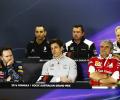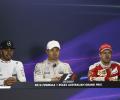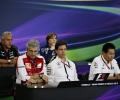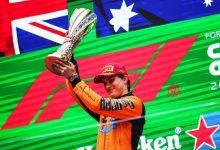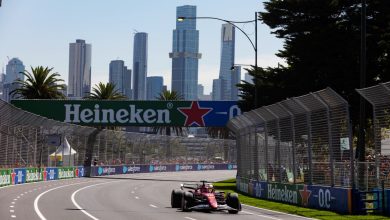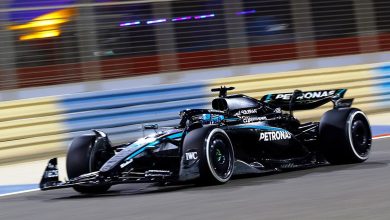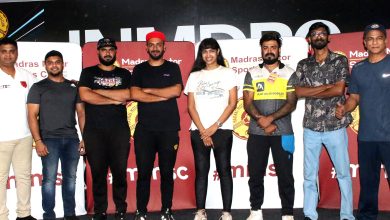Competition from 3rd to 6th place is very challenging: Bob Fernley of Force India
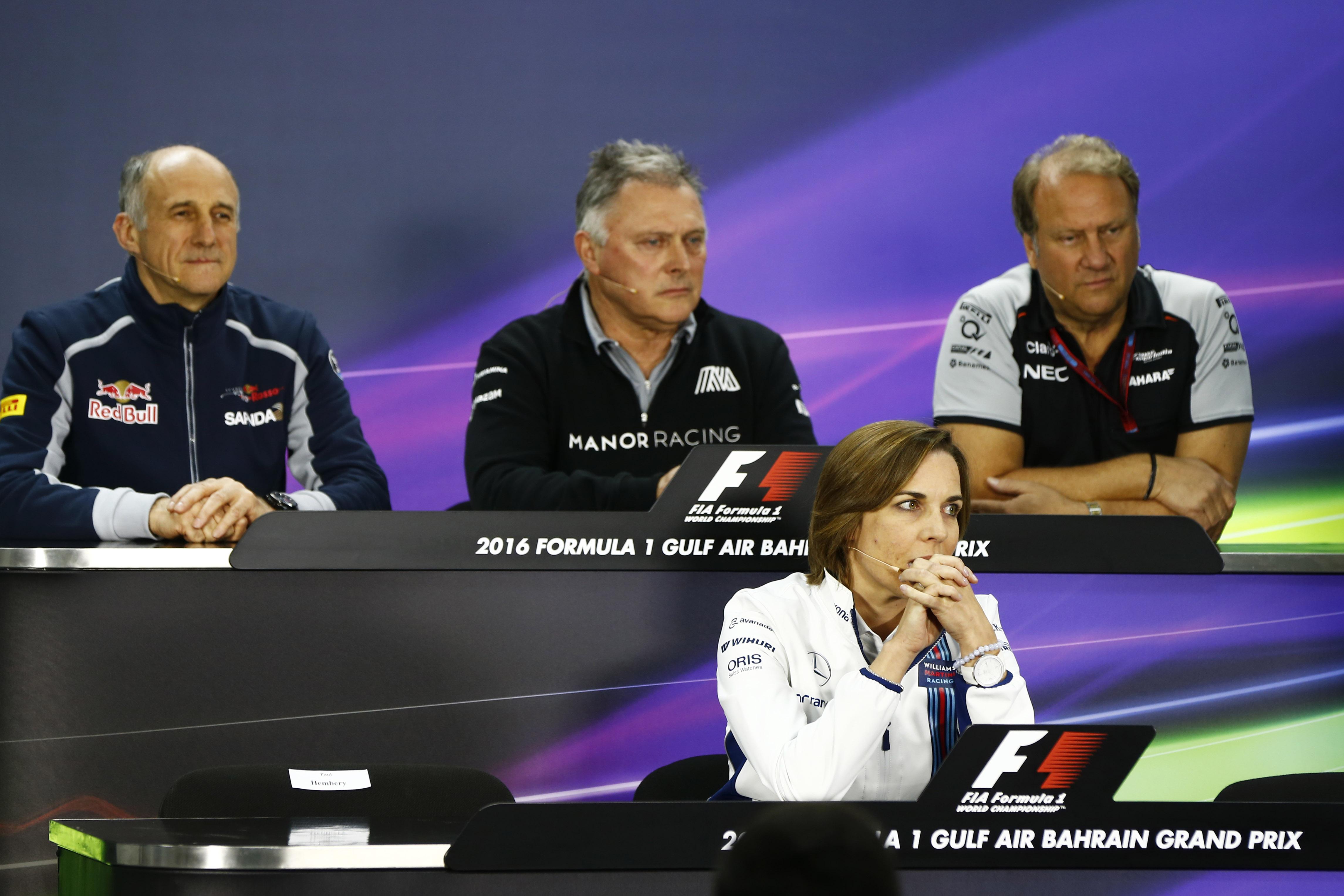
TEAM REPRESENTATIVES – Franz TOST (Toro Rosso), Dave RYAN (Manor Racing), Robert FERNLEY (Force India), Claire WILLIAMS (Williams)
Not in attendance: Monisha KALTENBORN (Sauber), Paul HEMBERY (Pirelli)
PRESS CONFERENCE
Bob, the car showed some flashes of real speed in pre-season in testing and in Melbourne you had a good result with seventh. How confident are you that you’ll be able to take a step on from the fifth place overall the team achieved last year? ?
Robert FERNLEY: I wouldn’t say that I was overly confident but optimistic. I think that Toro Rosso have done a good job. Williams are always strong. Red Bull are coming back and the engine’s proving well there. So I think the competition for that third to sixth place in the Constructors’ Championship is going to be very, very challenging this year and very tough and we’ve just got to prove that we’re up for it.
Talking about Toro Rosso and other teams, in the second half of the race in Melbourne, Romain Grosjean in particular was able to stay ahead of the Force India. Were you surprised at the pace of the Haas and do you think that everybody has closed up behind you, quite tightly?
RF: I don’t think that necessarily the Melbourne pace was something worrying. Melbourne’s just a very difficult circuit to overtake on and I think the red flag played in the favour very much of Haas. In our case I think it went against us slightly. So I don’t think it was a pace issue particularly, just a circuit-related issue.
Thanks for that. Franz, coming to you, you got off to a good start in Australia, with a double points finish, and the car clearly has some pace. That obviously puts the team in the spotlight, in many different ways. Does the improvement in the team’s pace make you attractive again for outside investors?
Franz TOST: I hope so. At Toro Rosso the doors are always open for people who bring money, because we have many ideas how to invest it in a proper way. Of course it’s easier to negotiate with partners if you are successful at the race track. This year, so far, we have a very competitive package. The STR11 shows a good performance; also both drivers are very skilled and very fast. The engine is also good and the team has improved as well and therefore I expect to have a successful season and I hope that we can find additional money.
That improvement in pace was evident in Melbourne but you might not have got the race result you wanted. Obviously, we all saw what happened with Carlos and with Max in the pit stops. Have you spoken to the drivers in between and how has that been resolved?
FT: Yeah, we had a very good first part of the race until the red flag. After the red flag we lost the pace. The reason why we called in Carlos was that he had a lot of vibration on the front axle and for safety reasons we wanted to change the tyres. Max then came into the pits and the team didn’t know this and we were too late with the tyre change. Therefore, he came out behind the group of Grosjean, Hulkenberg, Palmer and behind Carlos and then of course there was a little bit of a fight between them. But that’s normal. That’s competition. We discussed everything after the race, we analysed everything and we explained to the drivers what happened. Everything is sorted out and I expect from them a good and competitive race here as well.
The battle between the drivers looks like it might shape up to be one of the season’s most intense. How do you, in the team’s best interest, manage them, given that they a relatively young partnership?
FT: You must not forget that both of them are very young. Both of them want to make a career in Formula One and therefore they are fighting for every millimetre. This is what we want to see and therefore why we also have them in the team. At Toro Rosso the philosophy is not to come out with a team order, to say ‘you have to let the other past’. Only if we change the strategy, of the drivers are on a different strategy and if we think it will be an advantage for the team, then of course, but otherwise there are no team orders. We expect discipline from the drivers. What do I mean by discipline? That they respect each other, that they let the other driver the space to survive, that they don’t crash on each other and that they compete on the race track like people want to see it and then we will see who will be the better.
Dave, welcome back, a couple of questions for you. Your car seemed fairly comfortable running in the lower midfield in Melbourne. What kind of result of results do you expect from the rest of the season, what’s achievable?
Dave RYAN: I’d like to think we can run with the pack. We haven’t been able to do that in previous years. If we can do that then we can be in a good position to seize opportunities that come our way. I believe we can score points and we need to score points, and that’s the goal.
You’re almost six months into your tenure at Manor. When you arrived what did you feel were the things that most urgently needed addressing and now where do you feel the team is at now in terms of personnel, resource and operational stability?
DR: The team was clearly, or had been, in a very difficult place. They did a fantastic job last year. They were in a bit of a holding pattern really. Most of last year was spent looking forward to getting a package together for this year. Stephen Fitzpatrick, our team owner, did a great job on that front: he secured a terrific engine deal, a great transmission arrangement. After that, it was just a question of putting a good car together, which our guys have done. So, last was a bit of a holding pattern and it was all about getting ready for this year. We’ve got a pretty good package. There are no excuses on the engine front, the driveline, and it’s down to us to show we belong here – and we do. And we’ve managed to change the team considerably. We’ve got a lot of new people. There were a lot of good people anyway. Even from Melbourne to this race it’s developed, it’s changed a lot and we’re going forward and that’s what we need to see.
And what about your drivers? They are both quite inexperienced. What do you see is the potential from both of them?
DR: I see huge potential. First of all they’re both young guy, a bit like Franz was saying. I enjoy their enthusiasm. Having youngsters around is very invigorating. They’re both very, very switched on young guys. Quite different personalities but fierce determination in both of them to succeed and I’m sure we’ll see two very good drivers develop during the year.
OK, thanks. Claire, coming to you, lonely at the front there…
Claire WILLIAMS: I have no friends!
Williams have finished third in the past two seasons. This year, do you see it as the same battle again, against Red Bull for that third position, or has there been that step over the winter that will allow you to take the fight to Ferrari and Mercedes?
CW: I’d like to think so. As you say, we’ve come third in two consecutive seasons now, which is a fantastic achievement for Williams. But we did come into this year knowing and understanding that it was going to be much harder to try to maintain that position, let alone push forward and try to catch the Ferraris and Mercedes, but of course that was the target for the guys back at Grove over the winter period. I think in Melbourne it was far too early to tell really where anybody is on the grid this year, so we’re going to have to give it a few races to see where we are, but of course the target for us as a team is always to make improvements. We’d love to be able to close the gap to Ferrari and Mercedes, but I think we’ve seen in Melbourne that the competition has closed around us. The Force Indias, the Reds Bulls, the Toro Rossos, they are all there. We had a great fight in Melbourne and I expect the rest of the season will be like that, so we have our work cut out if we are to maintain third, let alone push forward.
One of things you have been working on is the new short nose that is supposed to be arriving. Are we going to see that tested tomorrow? Has it arrived? Is it arriving?
CW: It is winging its way here as we speak, so I very much hope it will be on the car, it’s going on Felipe’s car tomorrow in P3, and we’ll just have to understand where it is, what performance it’s giving us and then decide whether we run it in qualifying or not.
QUESTIONS FROM THE FLOOR
Q: (Kate Walker – motorsport.com) A question for everybody please. We’ve had an awful lot of doom and gloom – and I’ve very over that. Could everybody please tell me one thing that you’re looking forward to about the 2016 season. Something that excites you, that makes you passionate.
RF: If you look at it from the point of view that probably the first… the manufacturing teams in terms of Mercedes and Ferrari are clearly ahead of the game, I think what’s exciting for me is what Claire’s just hit upon: I think we’ve got four or five teams that are really fighting hard for those third to sixth places. I think that’s going to be an incredible battle through the year. If that was the front of the Formula One field, think how wonderful it would be for the fans.
Franz?
FT: We have a very competitive midfield where all the competitors are very close together, we go to Azerbaijan and see a new race, and we have 21 races.
Claire?
CW: The same as what everyone else has said: I think the competition this year is going to be phenomenal. I think we’ve had a couple of good years of racing. As I said, Melbourne really demonstrated that it’s going to be a really close fight for everybody this year, up and down the order, which is really exciting. I’m really pleased with what you said about the doom and gloom, because I’m totally over it as well and I think it would be really nice if we recognised the positives of our sport, of which there are so many. I think actually now Formula One, from a strategic perspective, and looking at where we’re moving forwards to into the future to into the future, now coming close to signing off the new power unit regulations – hopefully – in addition to the new 2017 regulations, I think there’s a lot to hopefully look forwards to. I think the driver aids situation, as much as there’s been a lot of talk around that, positive and negative, I think that’s really exciting: the drivers have what they wanted, and that’s to be drivers in the car again and to take control of their cars. For me, to see drivers going out there, having a fight, I think it will be a really exciting season. That’s what I’m looking forward to.
David, it’s a new role for you…
DR: Yes, I endorse that. Melbourne showed, or gave every indication of the season to come. For me personally it’s going to be… I’m really looking forward to the season and I’m going to enjoy seeing Manor Racing progress. That’s what I’m looking forward to most.
Q: (Dieter Rencken – Racing Lines) A question to Robert Fernley. Bob, there’s been a fair amount of negative coverage about your team owner, team principal Vijay Mallya recently. He’s not here so I need to ask you. Is the team endangered in any way? We hear some stories of $400million dollars being offered in repayment. How does that affect the team?
RF: You know Dieter, I didn’t see you behind the camera – I thought I’d got away with it for this meeting! Vijay’s issues are well publicised but, like all things, I think there’s been a bit of media over-reaction, especially from India on all of that. It’s something, just to give you an idea of India itself, I’ve been in and out of India for well over 30 years and the only thing I’ve learnt in 30 years is how little I know about India, so I think you’ve just got to let that flow and for Vijay to deal with it. Force India is blessed with a very good technical team and that technical team has progressively moved Force India up the Constructors’ table and I think today we are realising some of the best returns the team has ever had from the payments side of things, even though we complain about the disparity – which is a separate issue. And we also have a very good commercial team. And I think the commercial team is allowing Force India pretty well now to stand on its own feet and, whilst the shareholders are always there to help us – and Vijay’s been the main person in doing that over the last nine years. It’s not a short term, nine years, to be keeping a Formula One team going. I don’t think there’s any concerns for Force India.
Q: (Dieter Rencken – Racing Lines) Claire, very brief one to you. You’ve just said you’re signing off the 2017 powertrain regulations and ‘hopefully’ the 2017 aero regulations. Can you elaborate on why you use the word ‘hopefully’? I doubt you normally use words willy-nilly.
CW: I think I should have applied ‘hopefully’ to both. We have a Strategy Group meeting that’s just been scheduled coming up, and as we all know in Formula One, things are fluid. I said ‘hopefully’ just to temper it. I don’t think you should put too much emphasis on that word.
…so there is a chance that they may not go through, based on that?
CW: I doubt it. I think it’s becoming far too late in the day. I think we pushed the date anyway and we need to get these signed off if we’re all to be ready for 2017.
Q: (Dieter Rencken – Racing Lines) My second question to all of you. There’s been a lot of noise coming from the GPDA recently and one of their points of concern is that they’re not being heard, particularly when it comes to the governance structure, regulations changing etc. given that two of you people are on the Strategy Group and the other two on the Formula One Commission, have the drivers aired their concerns to you at all as team principals on the various commissions and groups?
BF: No, I’ve not spoken to any of the drivers on that Dieter. I think the drivers have got a role to play. They do have a meeting every race weekend with Charlie so they do represent their views at that meeting and those are transmitted to us through Charlie, which is the correct way of doing it. I think it’s very difficult to have a member of the GPDA on the F1 Commission. It’s very difficult to represent 22 people with one opinion. We have enough difficulty doing it with six on the Strategy Group, so I’m not sure where that would go. Clearly the voice of the drivers is very, very important and we should be listening to them.
Claire?
CW: Yeah, I echo what Bob has said. The drivers are one of the key stakeholders of our sport, as are the teams, the media and our fans and we have to listen to all those stakeholders if we’re to create a sport that’s going to sustain in the long term. I’m pleased that they’ve come out and talked about their concerns. I think now we have to go away and think about them and address them and to see how we can engage them. Personally, in the team we have a constant and open dialogue with both our drivers and they always feedback information. On the converse, I think drivers have been listened to, probably more than they have in recent times, talking about the driver aids and the cars we are producing for them for next year – but as Bob said, it’s difficult to represent such a wide group. And then, how does that potentially fit in to the current governance structure that we have at the moment.
Dave, your thoughts on this.
DR: I think the drivers are the great personalities of this sport. I think they should be listened to. I think their opinion is really valued and we should heed what they say. We should certainly take notice, that’s for sure.
Finally, Franz.
FT: Our drivers are fortunately young, they are not so involved in all of this political issues. Generally the drivers are here for driving and, regarding the Formula One rules, there are so many parties being involved, it’s unnecessary to bring in another party. Nevertheless, the drivers can come up with ideas – but not after regulations are being defined. Like now, the 2017 regulations. To come now and say ‘this is not good’, it’s too late: because this has been defined. They should do it before. Generally, they should be concentrated to drive. That’s their job.
Q: (Sanjeev Palar – Fox Sports Asia) The fans are holding their breath to try and understand and then figure out what’s happening with qualifying, so perhaps someone can tell us how is it going to be resolved, are there going to be any more changes that we see this season, and what is the process and opportunity to implement such changes?
DR: We’re holding our breath as well.
FT: We’ve discussed this qualifying procedure many times and the reason why this new qualifying came into play is because the organisers wanted to increase the show. Now, we saw in Melbourne that qualifying three ended up in a mess, because during the last four or five minutes no car was out there, but this was already mentioned before, because the calculation of all the teams showed that at the end, maybe one or two cars would have tyres to go out twice in qualifying three. The new qualifying model itself is not so bad but in qualifying three, the eight cars need to have two sets of tyres so that all the cars are out there. Why? Because qualifying three is the most important part of the qualifying, it’s when pole position is being decided and therefore the cars need to be out on the track and neither the old qualifying… all this would be good, in combination with the new one because then the drivers would be out only at the last one or two minutes and with the new qualifying we know that the last four or five minutes no one is out any more. Therefore, in my opinion, we should go back to the old qualifying when we know that the cars will be on the track and will race for pole position.
CW: In qualifying, the revised form in Australia came out and we said we would give it a go and if it didn’t work we would revert and come back to the drawing board, and obviously that meeting happened on Sunday and everybody agreed that we would revert back to the 2015 format until we could all come together and decide and actually try and come up with a well considered revised process for qualifying. Unfortunately that obviously has happened in the interim, we’ve had a new vote among strategy group members which then went to the commission. Now we have this hybrid system which we’re running tomorrow. Personally, from a Williams perspective, we would have rather to have gone back to the 2015 format as a holding pattern, to give us time to meet again as a group and to actually have time to go through what a new system could look like rather than kind of go to a hybrid system which might not work again. I think we have to wait anyway and see whether that will work or not tomorrow and then take the time to actually think about it. I think otherwise our fans are just going to look at our sport and go ‘what are they doing?’ You can’t do this in the second race of a championship so it’s really important to us that we get this resolved as quickly as possible but to do it in a well-thought through manner.
Q: Dave, your drivers were probably disadvantaged in Q1 last time out, it didn’t probably go according to plan. What’s your feeling about it?
DR: No, it didn’t go according to plan for us in Melbourne. I think the important thing is that the regulations were changed for Melbourne, we did give it a try and it clearly didn’t work for many reasons. But the fans have overwhelming said ‘we didn’t like it’. We did have the meeting on the Sunday morning and we did agree to change it. However, since then circumstances have intervened and we’re now back to what we had in Melbourne, so I guess we’re going to go through it again and just see how it pans out. Maybe we’ll all be a bit better prepared for it this time round and maybe it will be a bit different. So let’s see what happens in qualifying tomorrow and we’ll review it again on Sunday morning.
Q: Bob, do you think teams will be a bit more comfortable with the process tomorrow and it might go a bit more smoothly than it did in Australia?
BF: For sure I think teams will be better prepared. There still could be issues with it. From a personal point of view, I would like to have seen the compromise programme come in because I think that actually Q1 and Q2 were quite exciting. Clearly we got it wrong for Q3. I would have liked to have seen a little bit of an adjustment before we stopped everything but we have to go, at the end of the day, with the way the governance system works and we are where we are and let’s see how it goes tomorrow.
Q: (Sanjeev Palar – Fox Sports Asia) Everyone has expressed their opinion on what they prefer but I think what we’re trying to understand and what we’re trying to convey to the fans is what process happens to decide what the final qualifying system will be for 2016, because it doesn’t seem like we have one. We had one in Australia, then we thought it’s gone all over the place, so what is the actual process to finalise the qualifying system that we’re going to have for this season?
BF: It has to go through the strategy group and then from the strategy group it has to go through the F1 commission. You need 100 percent of the votes from the teams, the F1 commission, and then if it gets the majority that’s necessary, it will go back to the world council to be put into sanction, so that’s the process. There is no other process.
DR: I think it’s true to say that once it passes through the strategy group for the Formula One commission, it can’t be changed so it can only be approved or disapproved from that point on, both at the Formula One commission and beyond. We only get what comes through from the strategy group, so that’s the process and then we vote on it and it’s a yes or a no, not a maybe we can do this instead, so that’s the process, it is very clear cut in fact.
eom/FIA transcript of the Press Conference

